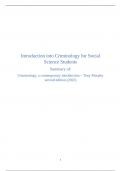Samenvatting
Samenvatting Criminology - Introduction into Criminology for Social Science Students (RGBUSTR007)
- Instelling
- Universiteit Utrecht (UU)
- Boek
- Criminology
Passed the exam with a 8,2! Concise and clear summary of 'Criminology - a contemporary introduction' By Tony Murphy, second edition. Needed for the compulsory course: introduction into criminology for social science students (RGBUSTR007), part of the minor criminology at University Utrecht. Tent...
[Meer zien]





